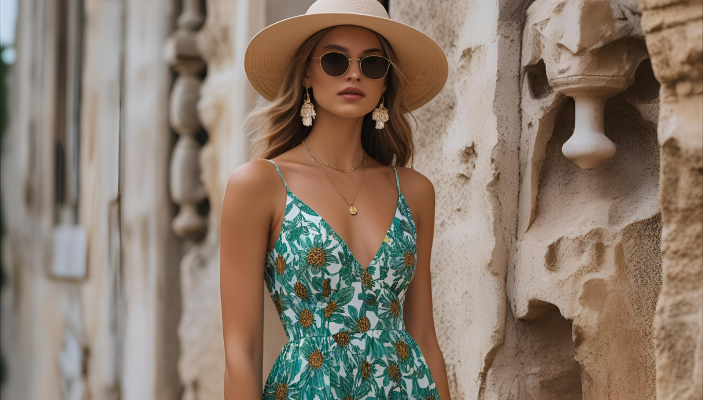Table of Contents:
- Introduction: The Evolving Warm-Weather Wardrobe
- Why Summer 2025 Marks a Shift in Fashion
- Core Trends to Watch This Season
- Fabrics Making a Statement
- Sustainable Choices Leading the Market
- Color Palettes That Reflect the Season
- Silhouettes and Shapes Embraced in 2025
- How Designers Are Responding to Comfort & Climate
- Influences from Social Media and Streetwear
- Tips for Finding Dresses That Fit Your Style
- Shopping Mindfully: What to Prioritize
- Brands That Reflect the 2025 Aesthetic
- Final Thoughts: Dressing for Comfort, Expression, and Change
- FAQs
1. Introduction: The Evolving Warm-Weather Wardrobe
Summer 2025 brings a refreshing direction in women’s fashion. While past years emphasized maximalism or nostalgia, this season focuses on functionality, personal expression, and climate-responsive wear. Dresses—long symbolic of summer ease—are leading this transition.
This isn’t about recycling trends. It’s about redefining the summer wardrobe through meaningful choices that reflect shifting societal values, improved fabric technology, and cultural influences from global platforms.
2. Why Summer 2025 Marks a Shift in Fashion
Several global factors are shaping clothing choices this year. First, consumers are increasingly aware of their environmental impact. Second, the extreme weather patterns seen in recent summers are influencing what materials and cuts people feel comfortable in. Lastly, people are leaning toward authenticity—both in style and in the way garments are produced.
This shift is especially visible in summer dresses, where designers are experimenting less with hype and more with long-term value.
3. Core Trends to Watch This Season
Summer dress styles for 2025 are characterized by:
- Modular and transformable designs
- Minimal-seam constructions that promote movement and breathability
- Customizable fits, allowing wearers to modify length, straps, and cinching
- Soft tailoring for structure without discomfort
- Sheer layering that blends modesty with ventilation
These features go beyond visual appeal—they serve real purposes for climate adaptation, travel convenience, and sensory comfort.
4. Fabrics Making a Statement
Fabric choice in 2025 goes hand-in-hand with performance and sustainability. The leading materials include:
- Organic hemp-cotton blends – lightweight, antibacterial, and moisture-wicking
- Bamboo viscose – soft to the touch and breathable
- Regenerative wool-linen mixes – offering texture and airflow
- Recycled polyester – often used in printed pieces, reimagined with eco dyes
- Seaweed-based knits – gaining popularity for their skin-soothing properties
These textiles reflect a shift toward purpose-driven design, where comfort, sustainability, and longevity converge.
5. Sustainable Choices Leading the Market
In 2025, sustainability is no longer a niche—it’s the expectation. Brands that offer traceable sourcing, closed-loop production, and biodegradable packaging are setting the industry pace.
Key features of sustainable summer dresses:
- Plant-based dyes instead of synthetic ones
- Small-batch runs to avoid overproduction
- Digital sample processes to reduce waste
- Repair and upcycling services for older collections
Consumers are actively seeking out labels that offer transparency, without compromising on beauty or function.
6. Color Palettes That Reflect the Season
Color trends in 2025 are deeply influenced by the emotional needs of the collective. After several volatile years, the current palette reflects a desire for calm, celebration, and organic alignment.
Trending color families:
- Soft clay tones – reminiscent of sun-baked earth
- Marine-inspired blues – ranging from pastel sky to deep indigo
- Cooling citrus shades – lemon chiffon, lime zest, and pale tangerine
- Nude neutrals – matched to diverse skin tones
- Botanical greens – connecting fashion with outdoor vitality
Color here is both aesthetic and therapeutic—a response to climate, wellness, and cultural storytelling.
7. Silhouettes and Shapes Embraced in 2025
Silhouettes for summer dresses this year are defined by:
- Loose A-line structures for maximum airflow
- Empire waists reinterpreted in contemporary lengths
- Asymmetric hems adding subtle movement
- Cut-out placements that balance intrigue with airflow
- Smock-style backs and elastic gathers offering adjustable sizing
These choices prioritize ease of movement and versatility while honoring body diversity.
8. How Designers Are Responding to Comfort & Climate
Designers are now creating collections with thermal comfort in mind. They’re working with climate data, wearable tech reports, and fabric engineers to offer dresses that feel as good as they look.
Key comfort innovations include:
- Anti-odor fabric treatments
- UV-protective weaves
- Moisture-activated cooling panels
- Anti-chafe stitch placements
- Lightweight linings that resist clinging
This makes summer dressing practical even during heatwaves and travel-intensive months.
9. Influences from Social Media and Streetwear
While high fashion is evolving, streetwear and digital platforms are playing a massive role in shaping summer dress culture.
On TikTok and Instagram, the micro-trends influencing mass retail include:
- “Coastal cowgirl” aesthetics with prairie cuts and denim-trimmed sundresses
- Sportcore blends, like tank-dress hybrids with pockets
- Gender-neutral wrap silhouettes
- AI-generated prints, created with user interaction or collaborations
- Layered mesh with bold graphics, a nod to digital avatar fashion
These moments often come and go quickly—but their aesthetics leave subtle traces in broader design patterns.
10. Tips for Finding Dresses That Fit Your Style
Not every trend fits every person. When choosing summer dresses in 2025, consider:
- Body awareness: Prioritize garments that complement your comfort zones
- Lifestyle fit: Choose pieces you can wear for multiple settings (home, travel, events)
- Care requirements: Opt for machine-washable or wrinkle-resistant options
- Fabric feel: Try before you buy when possible—touch and comfort matter more than visuals
- Adjustability: Pieces with tie-waists, adjustable straps, or modular layers offer better long-term value
Fashion should empower, not restrict.
11. Shopping Mindfully: What to Prioritize
Mindful shopping is about choosing quality and intention over impulse and volume.
Here’s what to prioritize:
- Labels with verified ethical practices
- Timeless over trendy pieces
- Local or regional makers
- Repairable and recyclable dresses
- Outfits with a 3+ year wear forecast
This approach reduces clutter, saves money, and aligns with environmental ethics.
12. Brands That Reflect the 2025 Aesthetic
A few labels consistently represent the new direction of summer fashion:
- Mara Hoffman – Known for slow fashion, striking cuts, and bold sustainability
- Reformation – Continues to push circular fashion in wearable silhouettes
- Christy Dawn – Grown-to-sewn collections using regenerative cotton
- Neu Nomads – Affordable elegance with plant-based dyes
- Sami Miro Vintage – Limited-run collections upcycled from past garments
- AZ Factory – Tech-enhanced garments with built-in versatility
Each offers distinct values—but all contribute meaningfully to summer 2025’s dress culture.
13. Final Thoughts: Dressing for Comfort, Expression, and Change
The best summer dress in 2025 isn’t necessarily the most expensive or trendiest—it’s the one that fits your needs, aligns with your values, and feels right on your body. As we move into an era of climate-conscious creativity and inclusive expression, fashion is becoming more human-centered.
Whether you’re embracing linen shifts, modular wrap styles, or sheer layering with botanical prints, this season invites authenticity and thoughtfulness over hype.
Clothing becomes more than trend—it becomes language.
14. FAQs
1. What colors are trending for summer dresses in 2025?
Soft clay, marine blues, cooling citrus, neutral nudes, and botanical greens are popular.
2. Are sustainable summer dresses more expensive?
Not always. While some eco brands cost more, many offer long-term value and better durability.
3. What dress fabrics are best for hot weather?
Look for bamboo, hemp-cotton blends, and seaweed knits—they’re breathable and skin-friendly.
4. How can I tell if a dress brand is ethical?
Check for certifications, transparent sourcing, and sustainable packaging practices on their website.
5. Are modular dresses really worth it?
Yes. They adapt to different styles, body sizes, and occasions—giving you more for your investment.







